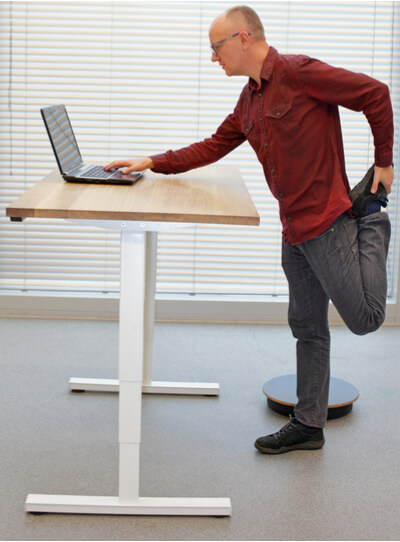10 User Mistakes to Avoid When Working At Adjustable Standing Desk

Despite a growing worldwide recognition by employers and workers alike of the potential long-term health and productivity benefits that can be derived from increased usage of a sit to stand desk, there appears to be a gap in promoting behavior changes to encourage people to utilize the standing capability of their stand-up desk. A study of German workers published in 2017 in the International Journal of Behavioral Nutrition and Physical Activity found evidence of this gap. Researchers reported that while 16% of respondents are provided with a sit-stand desk, only half utilized it regularly.
Sadly, merely using standing desks does not automatically lead to health improvements. However, when the stand-up desk is used properly, many of the health risks associated with sitting for extended periods can be avoided.
Top Mistakes When Working at a Standing Desk
To help you obtain the optimal health benefits that you can derive from using a stand sit desk, you must begin to avoid these 10 mistakes:
Poor Choice Of Standing Desk
When you finally make a final resolve to invest in a standing computer desk, you must inquire about mechanisms that allow the stand sit desk adjust correspondingly to your height and other personal characteristics like reach and preferences.
Staring Up Or Down The Monitor
Looking up or down your screen can cause strain on your nape, upper back, and shoulders. It also places an additional strain on your eyes. The ideal monitor height is eye level. If you are using a laptop or, use a low desk, you should consider getting yourself a laptop stand and a remote keyboard and mouse so you can raise your screen without shifting the pressure on your wrists.
Not Using A Typing Stand
If your job requires you to type copy either from a tablet or hard copy, you definitely need a typing stand. New models of convertible standing desks are including this as part of the frame and can likewise be adjusted to accordingly. The correct height of your typing stand is the same as the proper monitor height.
Improper Angling Of Wrists
So many desk-bound workers and freelancers get frustrated about getting wrist injuries and experiencing stiffness of finger joints. What’s sad is many believe that angling the wrists upwards on an inclined keyboard is the best typing position. The correct typing posture requires wrists to be positioned at a parallel, 180-degree angle relative to your arms and your keyboard. This is what is termed in ergonomics as the neutral position.
Feet Are Pressed On Hard Surface
Make standing up for hours more relaxing for your feet and legs. Explore a mat for a standing desk, so you don’t end up with a sore heel. Standing mats provide the best cushion when you’re standing while working.
Improper Posture When Standing
Many people forget to practice proper standing desk posture. How to stand at a standing desk? The proper posture standing against your standing desk is with a straight back, slightly bent knees and feet slightly apart to evenly distribute your weight. Make this your Number 1 rule: Don’t slack, although you should make sure that your bones, muscles, and nerves are relaxed.
Rare Position Change
One of the more attractive benefits of standing desks, weight loss is enhanced if you constantly take opportunities to shift your weight and move around more while working on a standing desk. You can do some exercises even as you type. At intervals, perform simple stretching exercises, stand on your toes to release pressure from your heels, put your arms up, and shake your wrists around.
Standing For Too Long
In general, staying in one position over a prolonged period places too much pressure on the same networks of bones, veins, and muscles. Common advice on how to use a standing desk is to keep shifting from a standing to a sitting position. Another option is to use a leaning stool which allows you to stay standing but provides support for your buttocks and lower back, while simultaneously freeing your legs from bearing your full body weight.
Using A Non-Cushioned Seat
Even people who are crazy about standing desks take a seat. However, if your chair is not built with your comfort in mind or even cause you back pains, then, you might deliberately refrain from sitting. You must carefully consider getting an ergonomic chair.
Leaning On Your Elbows Or Wrists While Typing
Few people realize that shifting weight support to the elbows or putting weight on the wrists can cause injuries. When habitually done, leaning on your elbows and wrists may cause arm-numbing pain, wrists, and fingers. It raises the risks for the median nerve, for instance, to become compressed, eventually leading to carpal tunnel syndrome.
Making The Standing Desk Work For You
The list of health benefits that can be obtained simply by using stand up desks properly keeps growing. How actively you move around while working at your standing computer desk makes a difference of course. Some of the standing desk health benefits include the following:
- Reduced risks for diabetes, hypertension and heart diseases
- Enhanced metabolism and better weight management
- Decreased risk for and better management of arthritis
And you’ll discover more of them when you will maintain the correct working posture.
Standing properly at sit-stand tables makes lots of desk jobs healthier and increase employees productivity. Now you are aware of 10 mistakes you might be making when using the standing desk. When you put these recommendations above in practice, you will know how to answer next time when somebody asks are standing desks good for you.





Comments